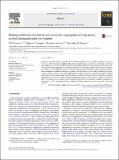Files in this item
Relations between residential and workplace segregation among newly arrived immigrant men and women
Item metadata
| dc.contributor.author | Tammaru, Tiit | |
| dc.contributor.author | Strömgren, Magnus | |
| dc.contributor.author | Ham, Maarten van | |
| dc.contributor.author | Danzer, Alexander M. | |
| dc.date.accessioned | 2016-11-07T10:30:51Z | |
| dc.date.available | 2016-11-07T10:30:51Z | |
| dc.date.issued | 2016-11 | |
| dc.identifier | 241482664 | |
| dc.identifier | b8c8aa75-265b-458c-9a4d-31b4d03ea32f | |
| dc.identifier | 84959517051 | |
| dc.identifier | 000397823200014 | |
| dc.identifier.citation | Tammaru , T , Strömgren , M , Ham , M V & Danzer , A M 2016 , ' Relations between residential and workplace segregation among newly arrived immigrant men and women ' , Cities , vol. 59 , pp. 131-138 . https://doi.org/10.1016/j.cities.2016.02.004 | en |
| dc.identifier.issn | 0264-2751 | |
| dc.identifier.other | Bibtex: urn:25d9295e2760bebbbb0d8a5a53d97a62 | |
| dc.identifier.other | ORCID: /0000-0002-2106-0702/work/64697560 | |
| dc.identifier.uri | https://hdl.handle.net/10023/9774 | |
| dc.description | The research leading to these results has received funding from the Estonian Research Council (Institutional Research Grant IUT2-17 on Spatial Population Mobility and Geographical Changes in Urban Regions); the Estonian Science Foundation (grant no. 8774 and 9247); the European Research Council under the European Union's Seventh Framework Programme (FP/2007-2013) / ERC Grant Agreement n. 615159 (ERC Consolidator Grant DEPRIVEDHOODS, Socio-spatial inequality, deprived neighbourhoods, and neighbourhood effects); and the Marie Curie Programme under the European Union's Seventh Framework Programme (FP/2007-2013) / Career Integration Grant n. PCIG10-GA-2011-303728 (CIG Grant NBHCHOICE, Neighbourhood choice, neighbourhood sorting, and neighbourhood effects). | en |
| dc.description.abstract | Contemporary cities are becoming more and more diverse in population as a result of immigration. Research shows that while residential neighborhoods are becoming ethnically more diverse within cities, residential segregation from natives has overall remained persistently high. High levels of segregation are often seen as negative, preventing the integration of immigrants into their host society and having a negative impact on people's lives. Where as most studies of segregation deal with residential neighborhoods, this paper investigates segregation at workplaces for newly arrived immigrant men and women from the Global South to Sweden. By using the domain approach, we focus on the relationship between workplace segregation, residential segregation, and the ethnic composition of households. Using longitudinal register data from Sweden, we find that residential segregation is much weaker related to workplace segregation than revealed by studies using cross-sectional data. Furthermore, the residential context is not an important factor in explaining workplace segregation for immigrant men. The most important factors shaping workplace segregation pertain to economic sector and city size. | |
| dc.format.extent | 8 | |
| dc.format.extent | 263646 | |
| dc.language.iso | eng | |
| dc.relation.ispartof | Cities | en |
| dc.subject | Workplace segregation | en |
| dc.subject | Residential segregation | en |
| dc.subject | Intermarriage | en |
| dc.subject | Longitudinal analysis | en |
| dc.subject | Sweden | en |
| dc.subject | 3rd-NDAS | en |
| dc.subject | SDG 10 - Reduced Inequalities | en |
| dc.title | Relations between residential and workplace segregation among newly arrived immigrant men and women | en |
| dc.type | Journal article | en |
| dc.contributor.sponsor | European Research Council | en |
| dc.contributor.institution | University of St Andrews. Geography & Sustainable Development | en |
| dc.identifier.doi | https://doi.org/10.1016/j.cities.2016.02.004 | |
| dc.description.status | Peer reviewed | en |
| dc.identifier.grantnumber | ERC-2013-CoG | en |
This item appears in the following Collection(s)
Items in the St Andrews Research Repository are protected by copyright, with all rights reserved, unless otherwise indicated.

